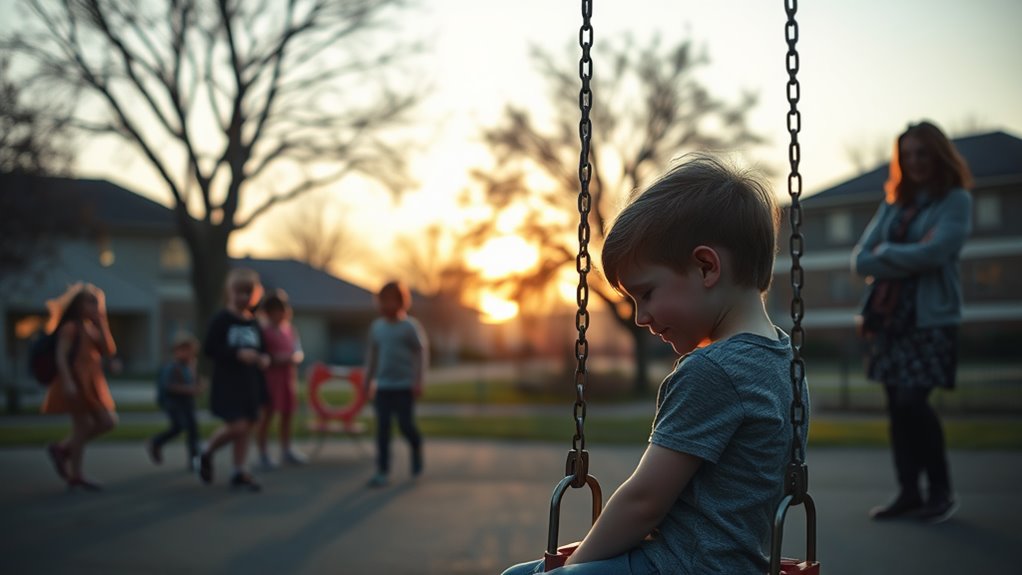How to Spot the Signs of Bullying and What to Do About It
Bullying often hides in plain sight, but you can learn to spot its signs. Watch for changes in mood or behavior, like increased withdrawal or anxiety. Physical signs, such as unexplained injuries or avoidance of activities, can also signal distress. Emotional turmoil may lead to headaches or stomach issues. It’s important to encourage open communication, allowing victims to share their experiences safely. Involve parents and guardians and educate peers on why intervention matters. Creating a supportive environment can make a difference. There’s so much more you can do to help and protect those affected.
Key Takeaways
- Look for emotional symptoms like mood changes, withdrawal from friends, and signs of anxiety or irritability in individuals.
- Identify physical signs such as unexplained injuries, avoidance of certain activities, and distressed body language like flinching.
- Recognize the impact of bullying, including isolation, anxiety, depression, and long-term trust issues that hinder personal growth.
- Encourage open communication and involve parents in discussions about respect, kindness, and the importance of reporting bullying incidents.
- Implement anti-bullying programs and foster peer support to create a safe environment and raise awareness among students.
Recognizing Emotional Symptoms
When it comes to recognizing emotional symptoms of bullying, you might notice changes in a child’s mood or behavior that seem out of character. They may become more withdrawn, isolating themselves from friends and family. This emotional withdrawal can be a significant red flag, indicating they might be struggling with feelings of sadness or loneliness.
You may also observe anxiety indicators such as excessive worrying or restlessness. If your child suddenly seems anxious about attending school or social events, it’s worth paying attention to. These signs can manifest as irritability or difficulty concentrating, making it hard for them to engage in daily activities.
Another emotional symptom to look for is changes in sleep patterns or appetite, as these often reflect underlying distress. If your child’s laughter turns into silence, or if their enthusiasm for favorite activities fades, it could be a sign that bullying is affecting their emotional well-being.
Identifying Physical Signs
Throughout the school year, you might notice some physical signs that could indicate your child is being bullied. Pay close attention to any unexplained injuries that seem out of the ordinary. If your child comes home with bruises and scars that they can’t seem to explain, it’s essential to take notice. These marks mightn’t always accompany a clear story, and that could be a red flag.
Additionally, look for any changes in your child’s physical demeanor. They might be more withdrawn or reluctant to engage in activities where they could be exposed to potential bullying situations. For instance, if they suddenly avoid gym class or playdates, it might be worth investigating further.
Keep an eye out for signs of distress, like flinching at sudden movements or becoming anxious when discussing school. The presence of unexplained injuries or changes in behavior could be indicators of a larger issue.
Impact on Victims
The impact of bullying on victims can be profound and long-lasting. You mightn’t realize it, but the emotional distress caused by bullying can affect every aspect of a person’s life.
Victims often feel isolated, as bullying can lead to victim isolation from friends and family. This isolation can make it even harder for them to seek help or support, perpetuating a cycle of loneliness and despair.
The emotional scars from bullying can manifest as anxiety, depression, and low self-esteem. When you witness someone being bullied, it’s crucial to understand that the effects can linger for years, sometimes even into adulthood.
Victims may struggle with trusting others or forming healthy relationships, as they carry the weight of their past experiences.
Physical symptoms can also arise, like headaches or stomach issues, stemming from the emotional turmoil they endure.
The combination of victim isolation and emotional distress can create a toxic environment that hinders a victim’s ability to thrive.
Recognizing these impacts is the first step toward fostering empathy and support for those affected by bullying, encouraging a healing process that can lead to recovery and resilience.
Effective Intervention Strategies
Effective intervention strategies are crucial in addressing and mitigating the effects of bullying. By implementing these strategies, you can create a safer environment for everyone involved. Here are some effective approaches you can adopt:
-
Encourage open communication****: Foster a culture where students feel comfortable reporting bullying incidents without fear of retaliation.
-
Utilize peer mediation****: Train students to mediate conflicts between peers, allowing them to resolve issues in a safe and constructive manner.
-
Involve parents and guardians: Keep parents informed about bullying incidents and encourage them to engage in discussions with their children about the importance of respect and kindness.
-
Educate bystanders: Empower those who witness bullying to speak up and intervene when it’s safe to do so, reinforcing the message that bullying is unacceptable.
-
Implement anti-bullying programs****: Introduce school-wide initiatives that educate students and staff about bullying, its effects, and effective strategies for prevention.
Supporting Affected Individuals
Addressing bullying involves not only implementing intervention strategies but also providing support to those affected by it.
It’s essential to create a safe environment where individuals can express their feelings and experiences. One effective way to do this is by fostering peer support. Encouraging friendships among peers can help those affected feel less isolated and more understood. When individuals know they’ve friends who care, it builds a support network that can significantly enhance their emotional resilience.
You should also consider the importance of open communication. Let affected individuals talk about their experiences and feelings without judgment. This approach helps validate their emotions and reassures them that they’re not alone.
Additionally, providing access to counseling services can be beneficial. Professional guidance can equip them with strategies to cope and recover from bullying experiences.
Frequently Asked Questions
What Are the Long-Term Effects of Bullying on Mental Health?
Bullying can lead to lasting emotional distress, affecting your mental health significantly. It often lowers self-esteem, making it harder to form relationships and cope with stress, resulting in long-term challenges that can persist into adulthood.
How Can Parents Help Prevent Bullying in Schools?
Oh sure, just wave a magic wand! But really, your parental involvement’s crucial. Engage with school programs, communicate openly, and support anti-bullying initiatives. Together, you can create a safer environment for all kids.
Are There Specific Bullying Laws in Different States?
Yes, there’re specific bullying laws varying by state. Each state’s regulations outline how schools must address bullying, ensuring student safety. It’s crucial to check local laws to understand your rights and protections against bullying.
What Resources Are Available for Bullying Victims?
If you’re seeking help, numerous resources exist for bullying victims. Support groups provide community and understanding, while online resources offer information and guidance. Don’t hesitate to reach out; you’re not alone in this.
How Can Bystanders Effectively Intervene During Bullying Incidents?
Did you know that over 60% of bullying incidents go unreported? You can empower yourself as a bystander by using intervention strategies like speaking up, involving an adult, or supporting the victim, creating a safer environment.





